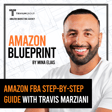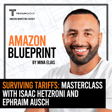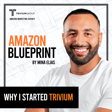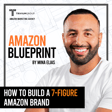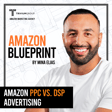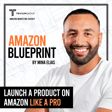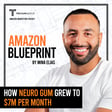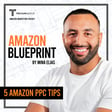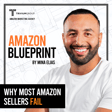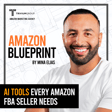Become a Creator today!Start creating today - Share your story with the world!
Start for free
00:00:00
00:00:01

5 Deadly Amazon Mistakes to AVOID in 2024
In today's video, I am with my good friend and Amazon expert James Lai. He's been selling on Amazon for 12 years and has seen it all. He's mentored many Amazon experts, like myself and Travis Marziani. He's also mentored a few of my clients who needed one-on-one help. James has seen it all! Today we discuss 5 deadly Amazon mistakes that you need to avoid when selling on Amazon. We have both made many mistakes over the years and these mistakes are avoidable!
If you're looking for an Amazon consultant for one-on-one help with James, click here: https://www.jameslai.co/
Need help scaling your Amazon Business? Click here for a free audit from my team: https://hubs.la/Q02L3Dkq0
Transcript
Introduction and Overview
00:00:00
Speaker
Welcome back to the Amazon Blueprint Podcast.
00:00:06
Speaker
Amazon is a lot harder now and it only takes one or two mistakes to seriously hurt your business. But in this video we're going to cover the five top deadly mistakes that people are making right now on Amazon and exactly step by step how to avoid all of these mistakes. These are mistakes that we have personally made and we've lost tens of thousands of dollars because of
Guest Introduction: James Lai
00:00:22
Speaker
these mistakes. I'm joined by my good friend and Amazon expert James Lai. He's been selling on Amazon for the last 12 years. He's been a mentor to people like me and Travis Marziani and he consults a lot of Trivium clients.
00:00:32
Speaker
And guys, make sure to pay attention to each and every mistake because each of these mistakes has cost me personally a lot of money. James, thank you
Mistake #1: Mismanaging PPC Campaigns
00:00:39
Speaker
for coming, man. Let's talk about the first deadly mistake, Amazon PPC. The first Amazon PPC mistake that people make is not monitoring their campaigns closely enough. Common behavioral pattern that customers make is that they'll create campaigns on a Friday and then they'll let it run and not check in on it until Monday.
00:00:54
Speaker
or Tuesday or sometimes they just forget about it entirely and they realize they're just blowing through their budget and they could have very quickly saved a ton of money by adding keywords to their negatives or turning things on and off. Yeah, I've been a victim of that too because a lot of times when I've created campaigns on Friday, I don't pay attention to them because I'm not working Saturday and Sunday and a lot of times they'll overspend when I could have just monitored it and if something's overspending, just add it as a negative. Definitely super important to monitor your campaigns closely. So as soon as you create them,
00:01:22
Speaker
monitor them every day until you dial them in. Amazing. And what are some other mistakes people are making in Amazon PPC?
Avoiding PPC Cost Pitfalls
00:01:28
Speaker
Okay, so another mistake for Amazon PPC that people make is not immediately adding negative keywords when they create their campaigns. So oftentimes you'll have a product that might have a similar keyword in it to another product that's completely unrelated.
00:01:40
Speaker
And so if you have a phrase match, when people search for a particular keyword that's related to your product, other keywords for products unrelated to yours will show up as well. And if you're aware of that from the beginning, as soon as you complete create the campaign, you can add those to the negatives. yeah So for example, this happened to me where I have an electrolyte powder and then there was this keyword amino acid hydration. People were looking for amino acids that had hydration in them, but that was not my product. My product was a strict, you know, hydration powder. I took amino acid, add as a negative phrase, and I never showed up for anything that has amino acid because my product doesn't even have amino acid. And if you're having a hard time figuring out if there are other products that have these kinds of keywords that will show up when you don't want to spend money on them, you can just very quickly add or create auto campaigns.
00:02:25
Speaker
and then monitor that really closely and you'll see all the other keywords that your at product is showing up for. And since we're on the topic of adding negatives, here's a very quick and easy way for you guys to audit your campaign. So what I like to do is I go into the targeting tab and in the targeting tab, I'll put some criteria. So orders equals zero and then I'll sort my spend and I can start seeing the largest to smallest amount of spend.
00:02:47
Speaker
probably do this for like last 30 days and any keyword that has spent, you know, 50 to 75% of my product sale price. So if I have a $30 product, anything that spent 15 to, you know, 22 and a half dollars with no sales, I'm going to go in either lower the bid or pause that keyword because it's just not converting. Now, I also do another filter where I'll do ACOS is let's say greater than 80%.
00:03:08
Speaker
and sales are two or less. So like one or two orders. A cost is high. What's the point of having those keywords? Let me lower the bids or again, pause them. And I'll do the exact same thing in the search term report. So download the search term report, put those filters in there, and then in this case, add them as negatives, right? Especially in auto broaden phrase, because you can add negatives. So I'd rather add the negatives first, and then later on optimize the bid. Let's also talk about outlier keywords. Okay, this is a really important one. And I think a lot of people get tricked by this. So this is a great way to save a bunch of money. If you take a look at your campaigns, you'll oftentimes see, okay, there's this keyword that has an amazing ACOS. Let's say it's like 5% ACOS and maybe it only had 10 clicks. This is where you actually have to use your brain. If you think about it, you look at the keyword and you're confused as to why anyone would have converted through this keyword. It just doesn't make any sense because it's so irrelevant.
00:03:56
Speaker
And sometimes these flukes happens. These are what we call outlier keywords happen. And so if you use your brain and you think, why would anyone buy my product through this keyword? The mistake people make is that they'll double down on that keyword. They'll increase the bid. They'll think, oh man, this is a 5% ACOS. This is amazing. Let's increase the bid on it. and Let's try to get more conversions.
00:04:14
Speaker
couple weeks later, they realized that that a cost is now 80 90%. Because it just didn't make sense. So sometimes you really just need to use your brain and say, Okay, this is an outlier. Maybe we shouldn't spend money trying to figure out whether or not this is actually going to be a good keyword, because I can tell just by using my brain that this keyword sucks. yeah Yeah, a lot of people are very robotic in their optimizations. They'll just go find keywords that converted, increase the bids, or, you know, graduate them, launch them in more campaigns. And, you know, I'm a fan of obviously taking a keyword that is converted and then trying to scale it. But if it doesn't make sense, don't spend money on it right away. Maybe wait until ah two or three conversions and then say, okay, maybe there's something I'm missing, right? I don't think this keyword should convert, but it's converted three times. That's enough data. Exactly. It's not enough just to use math and just to analyze the data. You have to use your brain as well. Yeah, yeah, yeah.
Maintaining Seller Performance
00:05:02
Speaker
All right, guys, deadly mistake number two, not maintaining a high seller performance. James, what are the mistakes people make, and which results in them not having a high seller performance, which then results in them hurting their you know business? Okay, so one thing that you want to take a look at is your order defect rate. If it's too high, also, if you're getting too many returns, that's going to affect your ranking in Amazon. So that everything will affect whether or not Amazon wants to promote you as a seller.
00:05:25
Speaker
or promote your product. So if you think about Amazon and the psychology of how they're thinking about their products that they're listing or they're promoting, they want to provide the customer with the best possible shopping experience. And if they know that your product has a high return rate or a defect rate, they're not going to promote that product no matter how well SEO your product is. The other thing that is really important is to pay attention to policy violations and take a look at your account health. Because if you start accumulating too many policy violations, if you have any trademark infringements, or anything that's just against Amazon's terms of service, they're also going to penalize you as a seller by not promoting your listing the same way as everyone else. So there's a new policy right now with shipping where you have to maintain a certain ah minimum amount of stock. And I think that's about 30 days now. And you have to be within that window and 180 days worth of inventory. And if you have
00:06:09
Speaker
less than 30 days worth of inventory or over 180 days worth of inventory, they're also going to penalize you and charge you additional fees for that. So this also affects your seller performance. If Amazon sees that you're possibly going to run out of stock pretty soon, it's not going to create a good experience for the customers. They're going to devalue your listing.
00:06:25
Speaker
Yeah, yeah, one thing that I've noticed a lot before they ever announced this is because we track in my real profit inventory levels at all times for in sales at all times for our clients. Every time someone started going under 30 days of inventory left at Amazon, immediately their sales worsened. And I was like, this can't be like a coincidence, right? Because every single client, the second that they drop under that 30 day mark, I'm like,
00:06:47
Speaker
Sales are down. Why? oh They're lower less than 30 days of inventory. And it makes total sense because Amazon only wants to promote the best sellers that are going to give the best experience to customers. And if you're running out of stock, it's a bad experience for customers because they want a product and they can't buy it.
Optimizing Listing Images
00:07:01
Speaker
All right. Deadly mistake number three, not split testing your images. We've talked about this a lot.
00:07:06
Speaker
Too many people will spend so much time building a beautiful listing. Really nice images, all of that good stuff. And then never touch it again. So walk us through why that is a mistake and how to fix that mistake. Yeah. So there's this common behavioral pattern among sellers, which they just set it and forget it because they regard the process of building out your listing and your images and the photography. It's a grueling and painful process for a lot of people.
00:07:29
Speaker
And so they're just super relieved as soon as they launch their product. And the problem is they never, they never continue to optimize it. They don't touch it again. So you need to be testing your listing copy and your main images all the time. So in the form of AB testing against your own copy or your titles or your images and AB testing against competitors as well. If you have a main image that's really well optimized and you look in the search results against your competitors and you can see that you really stand out, it is going to be a matter of time before your competitors recognize that this is a great main image and everyone's going to start to copy you. So what you need to do is regularly go in and see how you appear among the search results and constantly think of new ways to stand out among them. So main image optimization is super important. And just because it worked once, it doesn't mean it it's going to work
00:08:16
Speaker
over a long period of time. One of the benefits of main image optimization is a better click-through rate, obviously. And if you think of Amazon as just a funnel, right? At the top you have impressions, then you have clicks, which is people coming into your listing, and then you have sales, people converting. So with everything being the same and increase in your click-through rate means more people coming into your listing.
00:08:34
Speaker
with conversion rate being the same, it means more people are going to convert. So just by optimizing your main image, you can increase the number of people you know coming into the listing and converting. And not only that, but I've also noticed the better click-through rate results in a lower cost per click. And this goes back to the psychology of Amazon, where they want the best experience for their shoppers. And so when they see a product has a better click-through rate, it means more people want them. So they're going to show you up. You'll also probably get a better organic ranking. Exactly. Yeah. So the increase in click-through rates and conversions, that's ultimately going to be the biggest factor in determining your search engine ranking within Amazon. Yeah. And it all tracks back into making more
Continuous Product Improvement
00:09:10
Speaker
money. All right. So if I want to optimize my listening images and want to do some split testing, can you give me some step-by-step instructions I should take you know as a seller who maybe just starting out or hasn't optimized their listening images yet?
00:09:21
Speaker
Okay, so one of the main things that you can do for your main image is to show as much context as possible. So it's not good enough just to show your product bottle or the packaging by itself. So you want to show the context preferably if you can show the product in use that communicates so much more to the customer and increases your chances of getting that click through.
00:09:39
Speaker
The other thing is if you have your product packaging well designed, you should definitely incorporate that into the main image because that's additional real estate within the main image to utilize for marketing. So you can have text on there where normally you can't put text in your images, but if it's on the packaging itself and a lot of people will just have ah renderings of packaging done just so that they can get that additional real estate to put marketing messages within their main image. guys this is crucial please pay attention to this okay this is essentially you have a main image right and you can't do anything with that main image right because it's already your product but what you can do is you can create packaging and manipulate what's on that packaging so to have selling points so when someone types in electrolyte powder and in their mind you know they're looking for a sugar-free electrolyte powder that has hydration, whatever. You can't showcase that as much as you can on the bottle, but when you have a box in the back or something and you put these selling points and USD organic and you know featured in Forbes and all this type of shit, you basically are selling in the main image where you couldn't before. And obviously, the rest of the images you can sell a lot easier, but you know the main image is where you're capturing attention and you're getting people into the listing. Yeah, exactly. And the other things you can do is play around with colors, too. It's really hard to understand the psychology of the customer, and oftentimes trends change. So something that would work today might not necessarily work in a year. So you can test trending colors, color schemes on the packaging or or um on the product itself. And also one amazing thing is Amazon released Manage My Experiments, right? Where you can literally now take each one of your images and split test them on Amazon with the real data against older images. So that's definitely something I think everyone should be taking advantage of is go look at your images. This is what I like to do, right? And Data Dive makes this easy too, because you can pick like 10 competitors and it'll show you all of their images stacked against your image. And you can just browse through all the images and say, okay, what are the selling points of my product? What makes my product better than everyone else?
00:11:27
Speaker
Let's go look at the negative reviews. You know, Jungle Scout has this AI review analyzer. You can look at the summary of the negative reviews and positive reviews in each product. Summarize that stuff down and then each image should communicate why your product is better than everyone else. Why your product doesn't have any of the negative reviews. Why your product has all of the positive reviews. Because you know what someone's looking for. You know the problem that they have that you're solving with this product. You know what people have experienced negatively or what they've read in negative reviews. So if you can overcome all of those objections in the images,
00:11:56
Speaker
You're essentially going to make more sales. Yeah, yeah exactly. The goal is to convert a sale exclusively through images. So you have the power of visual communication. So when you plan out how you want to set up your nine different images, basically want to walk the customer through the sales process. You can introduce the product. You can make sure that you show a hero shot of the product, something that looks really visually striking and beautiful. You want to show the product in use with context.
00:12:22
Speaker
You want to show other things like how yours compares to a competitor. Make it very easy for them to see the pros and the cons or like us versus theirs. Any other warranty information or any other benefits from your brand. Deadly mistake number four, not improving your product. This is by far the number one reason I think sellers and brands, they shut down their business because they launch a product that was good and then they never make it better again. And then guess what? Chinese competitors, they see it, they make the product, they copy them and you're done because they're cutting you like half the price, right? So tell us about this deadly mistake and how can people avoid it? The main thing that you need to do is just to understand that you're not going to make a perfect product.
00:13:00
Speaker
If you have version one, version two, version three is going to come out and it should come out and your customers will understand that over time. You need to pay very close attention to the customer messages, the questions that they have, the negative reviews that you're getting, the negative reviews from your competitors as well.
00:13:15
Speaker
Because instead of treating this as something that's negative, it's actually a positive. It's a blessing to have basically the market ah give you feedback, basically focus group for you to tell you exactly what they're looking for in your product. Yeah. Every negative review essentially has a reason why someone didn't like your product.
00:13:31
Speaker
And sometimes it's preference, right? And there's not much you can do that, right? Maybe you can launch some different variations. That's like a a good thing too. But essentially, every negative review tells you why someone didn't like your product. And if you take all of those negative reviews, all of your competitors negative reviews, and then the second that you launch the first version of your product, you're already in R and&D for the next one. And then the second you launch the next one, you're already in R&D for the one after, you always stay ahead of the market. Because again, If I just see a product on Amazon and you know that Chinese competitors are watching, right? If I see a product on Amazon and it's doing well, the first thing they're going to do is going to be like, amazing. I can make this in my factory for 50 cents. Exactly. Yeah. So every time you order, that's an opportunity to make a modification to your product. You can think of it as improvement cycles every time you place an order with your factory in China. The other thing I want to touch on is a lot of people are reactive to other sellers. And this is a big mistake. and They see a seller improving the product in a certain way and they just think, okay, let me just do exactly that. If you're constantly just copying what everyone else is doing, you're always going to be a step behind the competition. So you should give yourself credit and have some respect for your ability to be innovative and creative in a way that no one else has done. So we like to do with our team is that when we innovate or come up with ideas to improve a product, we are not allowed to look at any competitors. So we have to come up with unique ways to improve the product from our own brains.
00:14:51
Speaker
And then afterwards, we can look at what the other competitors are doing, but at least give yourself some credit for your ability to innovate
SEO Best Practices
00:14:57
Speaker
and to be creative. The fifth deadly mistake on Amazon and one of the biggest ones is having a bad Amazon SEO. Walk us through what bad Amazon SEO means to you and how people can fix their Amazon SEO. Again, like as we mentioned that you need to constantly be testing, not just your listing images, but it's just as important to test your copy. So that's your titles, your features, and your descriptions. Bad SEO is when people think that all they need to do is stuff every field with keywords and all the different keywords. And it gets to the point where it doesn't read naturally anymore. So you'll just have a really poorly reading title or features or descriptions just because everyone's just trying to get that keyword density in there. So um let's not forget that it's not enough to rank well.
00:15:39
Speaker
What is actually going to help you rank organically in Amazon ultimately, like the biggest factor is going to be your sales and your conversions, right? So it doesn't matter how many keywords you have in your copy, if it's not going to convert because a listing just doesn't read well and it's just not good sales and marketing copy, there's no point.
00:15:56
Speaker
So the way you do it is first you start off with some keyword research. You can do these different tools like Helium 10 or Jungle Scout. What I like to do is I target two to three, what I call short tail keywords. And these are going to be the highest search volume keywords and the ones that you want to utilize to target in your title and your features, because those have the most weight. When you have your second or third tier keywords, which are also called long tail keywords, you can utilize your product description.
00:16:19
Speaker
to pepper that into the description naturally. What I personally do is I use chatgbt to incorporate the additional keywords so that it reads naturally so it doesn't sound like someone is just keyword spamming. That's the thing you want to avoid at all costs is keyword spamming. And Amazon's algorithms can pick that up very quickly. The other thing you can do to improve the SEO on your product page is make sure you fill out the FAQs, like the questions and the answers. So you can have friends ask questions. And in this section, this is where you can include keywords that are not absolutely related to your product, um but definitely will help. So you can even have people ask questions that incorporate other companies or other brands in there and say, like, how does this compare to whatever brand? And then you can answer it and you can use that to fill your product page with all these additional
00:17:06
Speaker
important keywords that's actually a a really good hack because sometimes you're not allowed to use certain keywords like weight loss testosterone or sometimes you know i can't use my competitors keywords like liquid ivy but if i can just say is this better than liquid ivy does this have sugar like liquid ivy and then it's all of this is seo building in my listing to liquid ivy which you know millions of people are looking for Yeah, the final thing I'll talk about in regarding SEO is that you want to make sure that you walk your customer through the sales process. It's not enough just to be you know a description of the product. You want it to be a sales process. so You want to make sure when they click buy, they have full confidence in knowing exactly what the product is, exactly what they're getting, exactly what the benefits are.
00:17:46
Speaker
So you can introduce the product, explain the benefits, explain how it compares with your competitors, any other guarantees that you have, but you want to leave the customer feeling completely confident with the sales purchase. Again, like if you have SEO content in your descriptions, like If you have just a bunch of keywords stuffed in there, it's not necessarily going to convert well, right? You might think, okay, cool. I have like, you know, 5% keyword density for my target keywords. If it doesn't convert, Amazon is not going to consider that strong ranking juice for your organic results. Ultimately, if
00:18:19
Speaker
it converts, that's what's going to boost you in the organics. Yeah, I love it. I completely agree. And I always like to think of Amazon SEO as where are other people getting their sales from and what are people searching and you know then landing on search results and making sales from. And then once I start thinking in that frame, it's now marrying sales and SEO at the same time because it can't just be beautiful copy that doesn't rank and it can't just be robotic SEO copy that doesn't make sense to the human being that's buying the product. Exactly. It's the art and science.
00:18:48
Speaker
And there you have it, folks. The top five deadly mistakes on Amazon. Do not make the same mistakes I made. Do not make the same mistakes James made. We lost a lot of money. We do not want you to lose a lot of money. So don't make those
Conclusion and Resources
00:18:58
Speaker
mistakes. James, thank you, man, for joining me. Where can people find you? You can find me on Instagram at Jim Skillet. And if you want, you can book a consultation call with me. Yeah, I'll leave his consultation called booking link in the description guys. So make sure to check it out. If you need help on Amazon, I can't recommend James enough. He helped me when I was starting out. I didn't know much about Amazon. He was one of my go-to people and he's been an amazing mentor to me for all these years. So see you guys in the next video. Thanks Mina.
